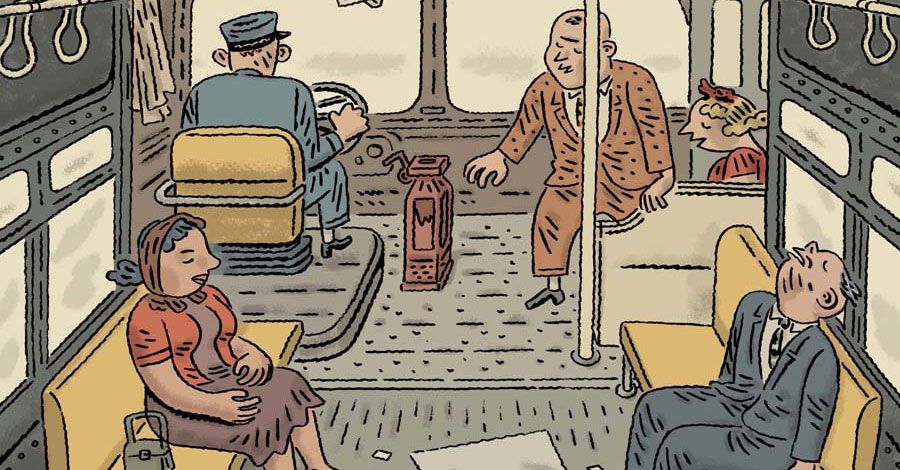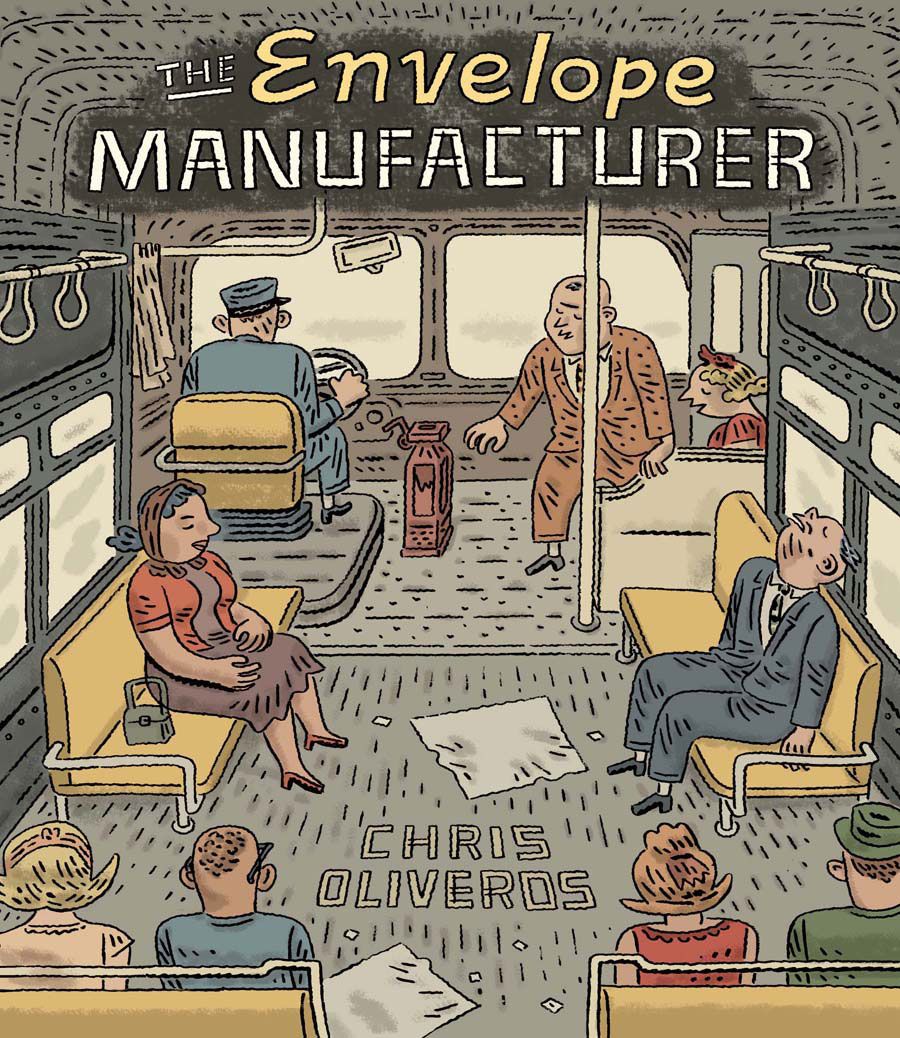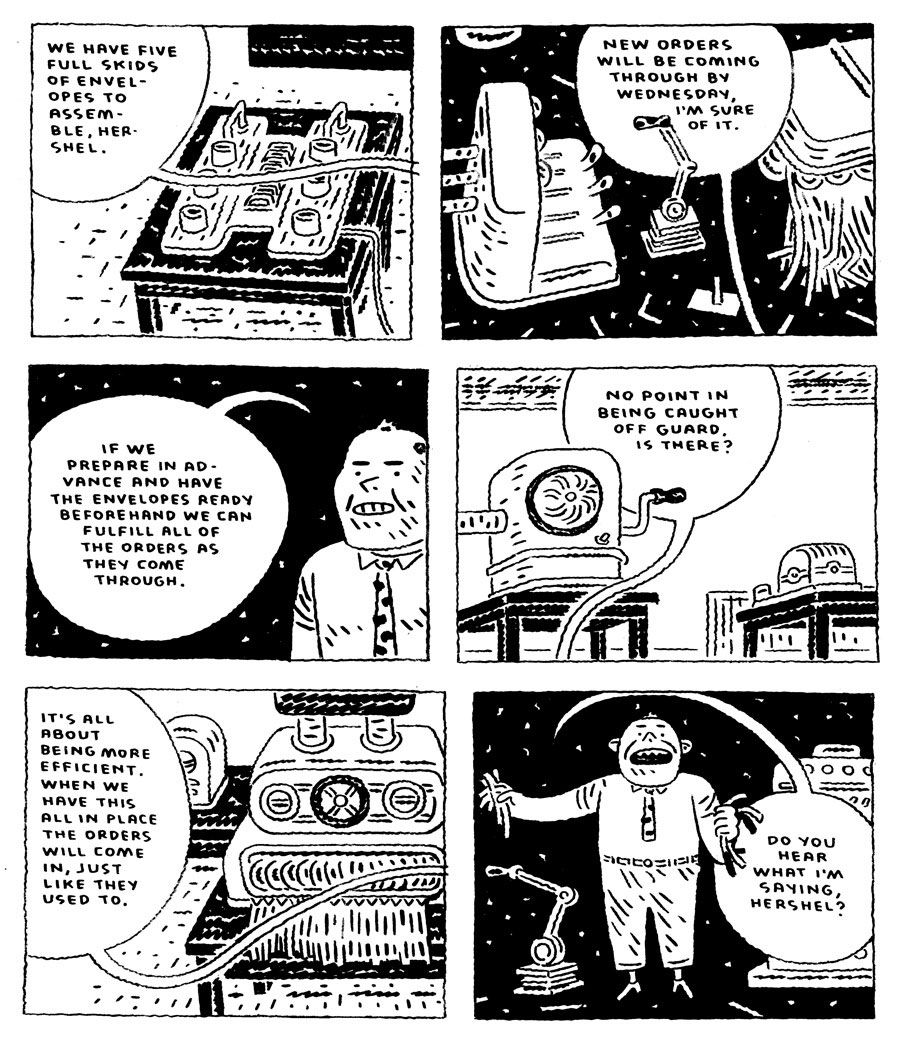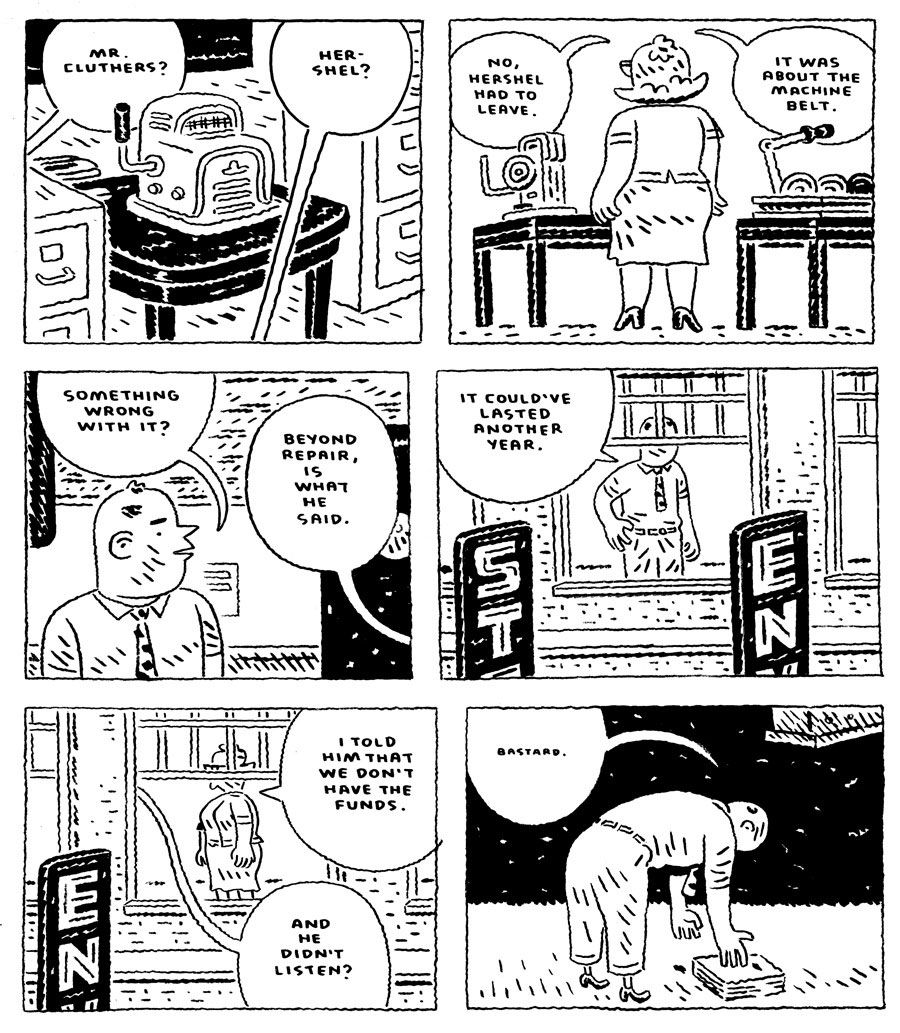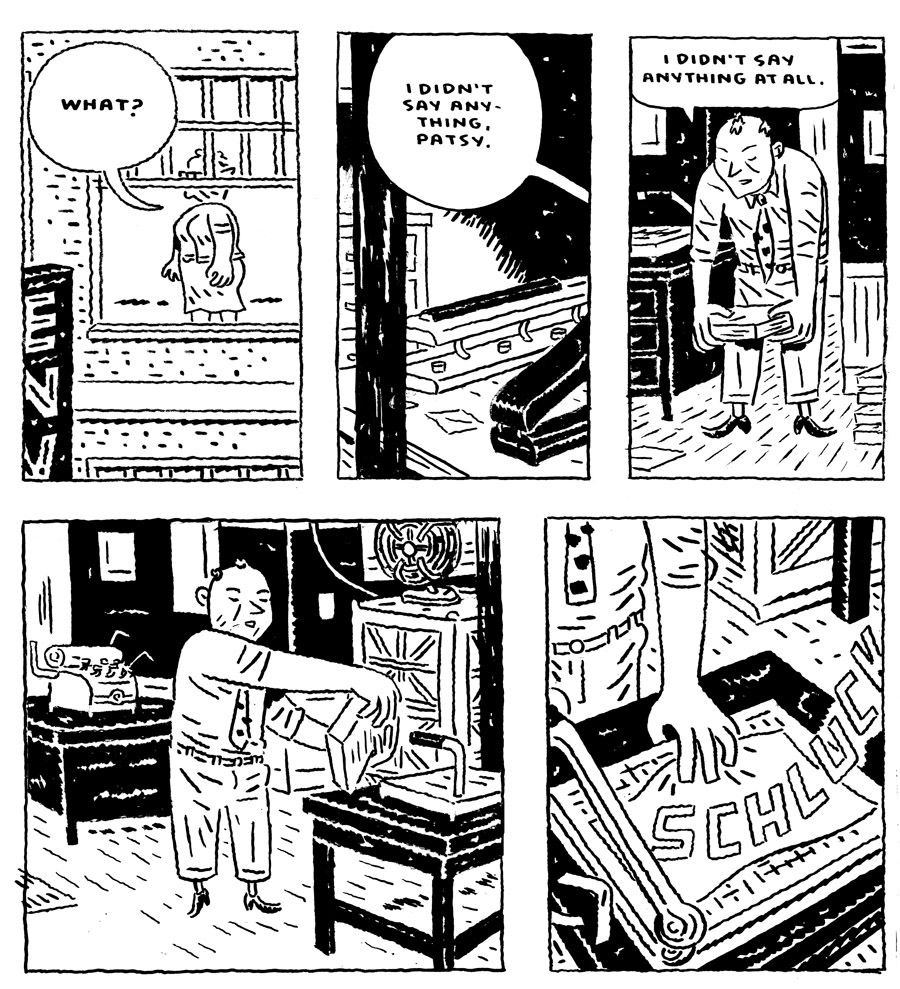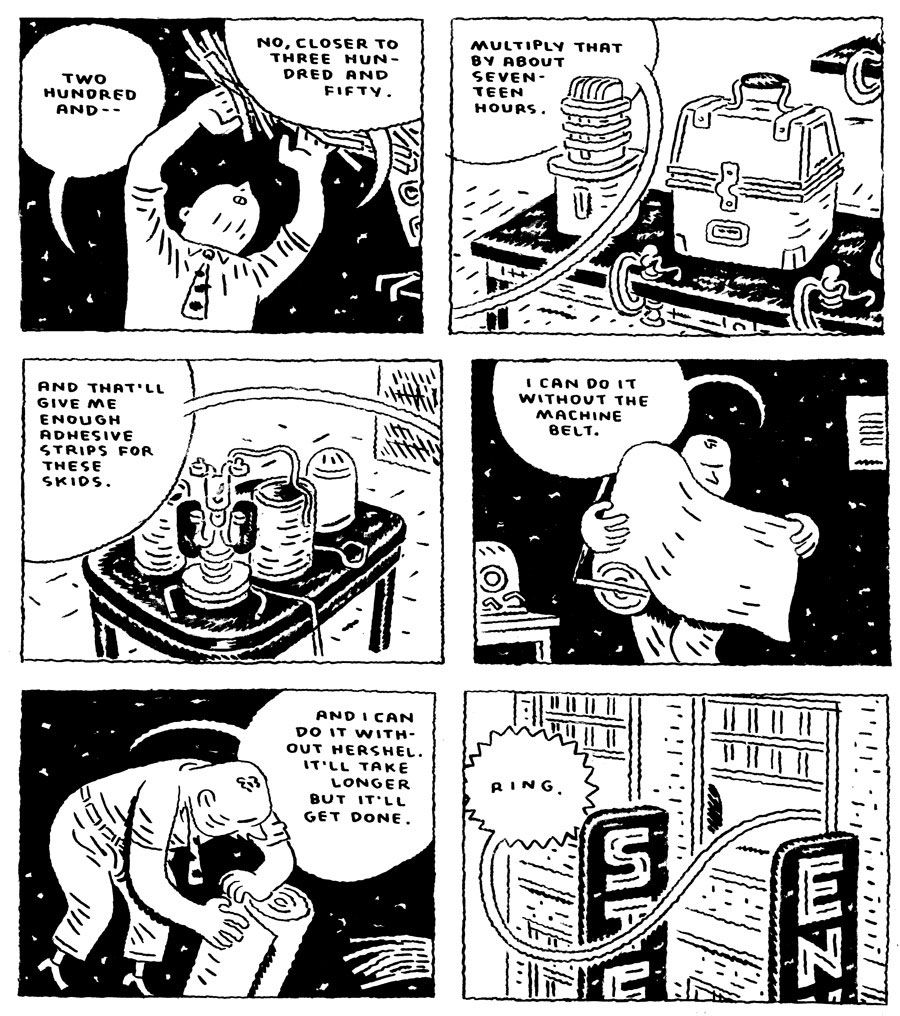Former Drawn + Quarterly publisher Chris Oliveros' debut graphic novel, "The Envelope Manufacturer," arrives in mid-January. Armed with a wealth of publishing practice, Oliveros is self-publishing, and his old friends at D+Q are acting as his distributor.
"The Envelope Manufacturer" draws on a subject Oliveros has plenty of experience with -- the struggles of running a small business -- though he's quick to caution that the book's autobiographical elements are few and far between. In his story's narrative, two men and one woman are all that remain to staff a failing envelope maker, each dealing with the company's bleak future in his or her own distinct and semi-delusional way.
CBR News talked with Oliveros about getting back to the drawing board after a quarter century away, facing the end of a dream, and how every cartoonist he's worked with at D+Q made this book possible.
CBR News: As the former boss man at a small business, Drawn + Quarterly, what made a story about the failure of small business appeal to you?
Chris Oliveros: I've always had some degree of fascination with small businesses in regards to how they operate and what keeps them running. I have a particular fondness for the kind of oddball businesses that seem to have defied everything by sticking around despite seemingly insurmountable obstacles and changes in the economy. So a story focused on this subject came very naturally to me, although I guess I'm somewhat amused by the prospect that some readers may take the liberty of interpreting this book as a sort of expose of my own experiences with Drawn + Quarterly. Sure, there are general similarities in regards to some of the bases covered: cash flow and accounts payable issues, the type of things that are not unique to any businesses that have survived for several decades. But beyond that, I'd like to think that I haven't completely lost my mind like the main character in this book, and that readers won't be taking all of this too literally!
When did all of the book's themes start to coalesce into a story?
The original idea came about at some point in the mid 1990s when I was regularly ordering envelopes in bulk from various suppliers for D+Q's mail order and subscription business. This would have been around the time that NAFTA came in, so this was really at the tail end of the period when small domestic manufacturers could still exist and make a go of it. For about a year, our main supplier was this older gentleman who likely had been operating his business for many years, but who was now clearly struggling to adapt to the enormous changes in the economy. At this stage his company seemed to have whittled down to the point where he was the last employee, even doing the deliveries on his own. I remember thinking at the time, "Jeez, this poor bastard. What will become of him?" And from that point I tried to imagine the details of his life and his business, how he got to this point, and ultimately how the inertia of impending events would lead to his ultimate demise.
You have two major characters at this failing envelope manufacturer. There's Herschel, who at times seems to be hate-working, holding out for back pay, getting deeper in the hole, but other times, he tries to believe in the company. He doesn't really see any other path for himself in life, does he?
I wanted to explore how people can sometimes find themselves stuck in a situation, with seemingly no possible resolution. There's a level of anxiety that persists and even grows throughout the story, as at least two of the characters attempt to cope by trying to convince themselves that things can get better. It's this delusional state that ultimately keeps them going.
Then there is the manufacturer himself, Mr. Cluthers, who is completely clueless. He doesn't understand anything his long-suffering wife says to him. His plans for the company are pipe dreams.
The story begins at the point where Mr. Cluthers and his company are already on a seemingly irreversible downward spiral. Self-deception becomes a survival technique for him.
There's a real thread of suicide going through the book -- obviously the entire company is "on the ledge," as it were, but both Herschel and Mr. Cluthers face the issue in very different ways and varying degrees of sympathy. Was it difficult to find the right analogy for the company and both of these men? Did you worry the book would become too bleak?
Hershel is an employee who is understandably upset because he isn't being paid in full by his employer, so his anxiety builds as he continues to stay on in the company in the hopes that somehow the money will trickle down his way. The situation of Mr. Cluthers is a little more complex, as he struggles to save not only his own life, but also the company itself. Yeah, for better or for worse the almost relentless bleakness sets in from the very beginning of the book and doesn't let up at any point.
The third employee, Patsy, doesn't seem to have any delusions about the company's state or future, but she diligently checks in and does her job. She's the glue, but what keeps her going in the face of inevitability?
Patsy is the most sensible character in the book: she can assess a situation clearly, without having her judgment clouded by self-deception. But ultimately even this self-awareness doesn't prevent her from being trapped in a situation that seems to be against her own self-interest. Of the four main characters in the book, Mildred (Mr. Cluthers' wife) is the only one with the strength and fortitude to set forth a plan to extract herself from an oppressive situation.
The book is not based on your company, but did any specific incidents of this fictional company's history grow from anecdotes in your D+Q experience?
There are no specific situations or anecdotes where fact and fiction merge, although I have to admit that during a few lean times over the years, I may have followed a variation of dividing up the schedules of accounts payable into three categories, according to Mr. Cluthers: Those who complain a lot, those who complain sometimes, and those who don't make much of a fuss.
Your artwork is very impressionistic. Everything has a solid outline, but the details are rendered in short, dashy lines. I found it somewhat reminiscent of R.O. Blechman. Do you recognize specific influences in your drawing?
Sure, I'm very fond of Blechman's shaky, expressive line quality. A lot of my own sensibility was shaped when I was a teenager in art school, when I developed a fascination with the work of artists like Ben Shahn, Max Beckmann and William Gropper. In more recent years, I've developed a real admiration for the drawings of Tibor Gergely. But ultimately I'd have to say I've been most inspired by virtually every cartoonist D+Q has ever published. My experiences working with so many talented cartoonists over these years have really informed the way I approach comics.
You were the publisher at D+Q for 25 years. Did you always intend to cartoon yourself? What took you so long to make this book your priority?
The funny thing is, I actually started out drawing comics first, and I suppose I was following some sort of vague goal at the outset to become a cartoonist. One thing led to another, and I started Drawn + Quarterly instead. I'm really proud of everything that has been accomplished with D+Q over this past quarter of a century, and it's been a real privilege and honor to work with so many talented people. But now that I feel that I've taken this as far as I could take it personally, it's back to square one for me, which is cartooning.
Although you're listed as the publisher, D+Q is distributing "The Envelope Manufacturer" for you, and you're listed as a consulting editor on its site. No doubt current publisher Peggy Burns has things well in hand, but how involved have you remained with D+Q?
I come into the office somewhat infrequently, but I'm still connected each day by email, and we discuss things like the books D+Q will be publishing in the coming months and years. But otherwise Peggy, Tom and the staff are running things now, and D+Q is in the best position that it's ever been in. Peggy is very smart and astute, and she has had a pivotal role in the evolution of D+Q over the past dozen or so years, so the publisher position is in the finest hands it'll ever be in. Tom is probably the best editor in comics over the past couple of decades, and he's helped to define much of what D+Q has become. And it goes on from there, with key and talented staff like Tracy Hurren, Julia Pohl-Miranda, and several others helping to shape and define D+Q. It used to drive me crazy that sometimes when D+Q was talked about the focus would only be on me, as if I was still the sole employee there. Now that I've stepped down, I'm hoping that some of the attention can rightly be focused on the other essential people there.
After 25 years as the publisher, what was it like to go after your cartooning dreams again? In all that time, did you ever think you'd never get back to cartooning?
It's a funny feeling to suddenly be able to spend so much more time cartooning, especially as this was never part of my long-term plans until relatively recently. I'm enjoying it, although the down side is that there is quite a lot of anxiety and self-doubt to deal with. Lynda Barry explored this feeling of creative paralysis in a short strip called "Two Questions," which ran in her book "What It Is." The two questions she refers to are: "Is this good?" and "Does this suck?" both of which are variations of questions that play in my head on heavy rotation while I'm working. It can be oppressive, but on the other hand it can have some value in the ongoing editing process.
And what's next for you?
I'm working on a book that looks like it'll be running in the 200-250 page range, all in color. It's still too early to talk about, as I don't have a lot of self-confidence and I'm always fearful that I'll screw up along the way and either I'll have to start over or ditch the project entirely. But now that I have more time on my hands, hopefully I can get this done in the next three or four years.

